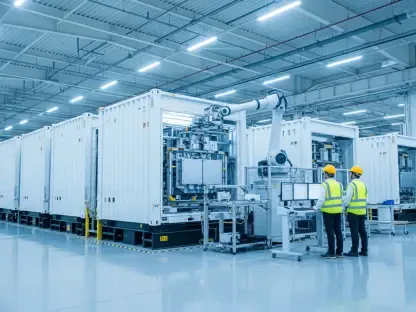Across the United States, the landscape of data center development has become a source of considerable complexity and challenge, particularly for utilities tasked with managing the expectations and impacts of such proposals. With the advent of digital transformation driving unprecedented demand, utilities now face the phenomenon known as “phantom data centers.” These often speculative proposals vastly outstrip those that are ultimately constructed and operational, posing significant hurdles in resource allocation, grid stability, and future planning. This surge in proposal submissions is not just a matter of quantity but reflects deep structural issues within the interconnection system, placing pressure on utilities to differentiate genuine needs from exaggerated forecasts, which inevitably complicates accurate load growth predictions and infrastructural investment decisions.
Discrepancies in Forecasts and Planning Challenges
The inconsistency in data center development forecasts presents a notable obstacle for utilities in crafting sustainable planning strategies. These forecasts often lean towards either extreme conservatism or overstated projections, creating a wide spectrum of anticipated power demands. For instance, predictions from RAND Corporation forecast a substantial requirement of 347 GW by the end of the decade due to AI-driven growth, whereas Schneider Electric offers more restrained estimates between 16.5 GW and 65.3 GW. Such variance underscores the inherent difficulty utilities face in distinguishing which projects will materialize into tangible infrastructure. Utilities find themselves grappling with unreliable data that ultimately leads to inefficiencies, as these speculative projections necessitate the reallocation of resources without definitive need.
The strategic behavior of tech giants like Microsoft, Meta, Amazon, and Google in submitting frequent and often redundant proposals adds another layer of complexity. Uncertainty regarding site selection and power availability prompts developers to propose more projects than necessary, straining utility resources. This saturation of proposals may result in the unnecessary overbuilding of infrastructure, leading to cost escalation and efficiency decline. These challenges in forecasting and planning are pivotal in ensuring that utilities can align their infrastructure investments with actual demand, offering a clear roadmap to address the ever-growing data center imperatives without compromising grid stability.
Navigating Interconnection Complexities and Transparency Issues
Interconnection requests endure a labyrinth of complications stemming from varying developer strategies focused on land acquisition and maintaining multiple queue positions to secure advantageous terms, all contributing to a lack of transparency. The uncertainty over developers’ intentions often leads to speculative oversubmissions, with a multitude of proposals competing for grid access. This strategic retention of queue positions compounds challenges for utilities, making it increasingly difficult to ascertain which requests warrant genuine prioritization. Experts advocate caution, urging utilities to scrutinize projections that regularly overestimate demand, highlighting a need for vigilance in assessing true development prospects.
Efforts to enhance transparency among developers, including anonymized LLCs and nondisclosure agreements, further exacerbate problems. Utilities are thus encouraged to establish standardized interconnection procedures that demand upfront financial commitments from developers, discouraging speculative submissions. This move could shift the paradigm towards more tactical, transparent engagement. Additionally, the outlook for nationwide standardized interconnection protocols gains traction among industry veterans and former regulators, underscoring the need to mitigate speculative entries. Such initiatives aim at fostering a clearer transactional environment between utilities and developers while simultaneously aiding utilities in optimizing their grid resources effectively.
Strategies for Managing Future Data Center Expansion
Despite hurdles, utilities are exploring innovative strategies to incorporate planned data center capacity efficiently. Proactive measures include greater advocacy for renewable energy to fulfill future demand, as illuminated by efforts from entities like Great River Energy. These utilities predominantly rely on federal funding to finance their renewable ventures, underscoring the viability of this approach for meeting burgeoning data center requirements. Nonetheless, they confront the persistent challenge of distilling actionable insights from a sea of speculative proposals—which projects will ultimately advance to construction and which will remain dormant aspirations.
On a broader scale, diversifying strategic approaches remains imperative for utilities seeking to safeguard existing consumer interests against speculative project overload. This diversification includes charging developers for comprehensive vetting procedures, requiring service agreements that align infrastructure investments with substantiated demand. Proposed legislative solutions, such as those from Texas, seek to subdue redundant requests and require developers to share interconnection costs, although the effectiveness of such measures remains debatable. These strategies highlight an industry-wide resilience, with utilities aiming to establish systemic efficiency and transparency that ensure new data center projects complement existing infrastructure dynamics.
Balancing Consumer Protections and Developer Commitments
The inconsistency in data center development forecasts poses a significant challenge for utilities as they attempt to create sustainable planning strategies. These forecasts often swing between being overly conservative and exaggerated, resulting in a wide range of predicted power needs. For example, the RAND Corporation predicts a substantial 347 GW demand by the decade’s end, driven by AI growth, while Schneider Electric offers much more moderate estimates ranging from 16.5 GW to 65.3 GW. This disparity highlights the difficulties utilities face in determining which projects will actually result in viable infrastructure. As a result, utilities deal with unreliable data that leads to inefficiencies and resource reallocation without a definitive requirement.
The tactics of tech companies like Microsoft, Meta, Amazon, and Google further complicate the situation. These companies often submit frequent and redundant proposals due to uncertainty about site selection and power availability. This behavior causes developers to propose more projects than necessary, putting a strain on utility resources. Such an overload of proposals can lead to unnecessary overbuilding, causing costs to skyrocket and efficiency to plummet. Addressing these forecasting and planning challenges is crucial to ensuring that utilities can align their infrastructure investments with actual demand, providing a clear path to meeting the growing needs of data centers while maintaining grid stability.









